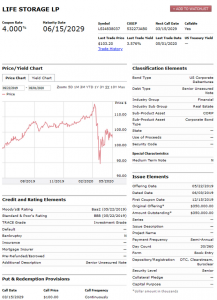Let’s take stock. The first post introduced our subject, so make sure you’ve read that before starting here. Our end goal will be to build a real estate private equity model that tells us if we should invest in these bonds. Naturally, the first question we want to answer is how much are these bonds worth today? This article will show you how to find that answer. After all, we can’t calculate any private equity real estate returns without understanding the price.
To begin, most investors think they need a prohibitively expensive annual Bloomberg Terminal subscription to figure out a bond’s price. Of course it definitely doesn’t hurt if you have one. But wouldn’t it be cool if you could get the same information for free? I’m going to assume you have no fancy tools, so let’s do this the old-fashioned way.
How I Found Free Bond Pricing Data
This is a play-by-play of my Googling, which I suggest you follow. Proactive research is the name of the game if you want to generate outsize private equity real estate returns.
So, a bit of Googling showed me that FINRA tracks bond prices through its TRACE system. Okay, how do I get that? Oh no, vendor agreements for realtime data seem a bit too intense for an REPE student. Maybe the non-realtime data? That “access” button doesn’t do anything.
Let’s back it out, Google for “finra market data free.” Aha, this result shows me this website and if I type the LSI ticker into the search bar I land here and I’m feeling great because I see “bond issues” so I click that. And I get very excited to see the 4.00 notes we’re trying to price. I click their link to this page and I can’t believe my eyes: free pricing data! Great, so no need for a fancy terminal (yet).
Excerpt of Bond Price Data
If we dig into the pricing data (at this link), we learn some interesting facts. These will all be key inputs into our future real estate private equity model. Screenshot below as of 5/3/20 to help you reference the data I’m about to call out.

Overview of Key Bond Terms
This is a beautiful trove of data and a healthy pausing point. You should make sure you understand everything above if you wish to proceed. This is basic information, and you need to understand every bit of it if you want to make heads or tails of this opportunity. Let’s dive in, and worth mentioning again this data is as of 5/3/20. Future articles will reference future data.
- Coupon Rate 4.0%: The interest on these bonds is 4.0% fixed on $350M principal, so bondholders receive $14M of annual interest
- Maturity Date 6/15/29: Bondholders will receive par on this data, and interest payments will cease on this date
- CUSIP 53227JAB0: CUSIPS are unique identifiers for securities. Just think of this as a unique code that always refers to this bond. More here.
- Callable (Yes) on 3/15/29: Bondholders can ask for their money back, or “call the bond,” any time after 3/15/29. This doesn’t mean much since maturity is 6/15/29. Would be more meaningful if it were several years earlier.
- Last Trade Price $103.50: Bond prices are often quoted in terms of $100. Don’t think too hard, it really just means % of par value. Thus, a price of $103.5 really just means the market thinks these $350M bonds are worth $362.25M ($350M*($103.5/$100)). Why is that? It’s all because the market would be willing to issue these bonds today at 3.86% (referred to as market yield, this is just the current coupon of 4.00% divided by price of $103.5). The risk curve has shifted, and thus the market will pay above par for some self-storage bonds promising 4.00% fixed yield (because a similar bond issued today would only give them 3.86%). Obviously there’s no such thing as a free lunch, so their price goes up (because interest rates have gone down). This is why investors always say that bond prices move inverse to interest rates.
- Credit Rating Baa2 / BB: Moody’s, S&P, and Fitch are the three most respected rating agencies. Baa2 is considered the lowest tier of investment grade, and BB is the highest tier of speculative grade (aka high yield) bonds. So this company has a split rating.
- There are a few other self-explanatory data points. You should make sure you understand these as well. If any questions, I’m always active in the forums.
Now that we understand the basics, the next post will dive into how we might analyze these bonds.
